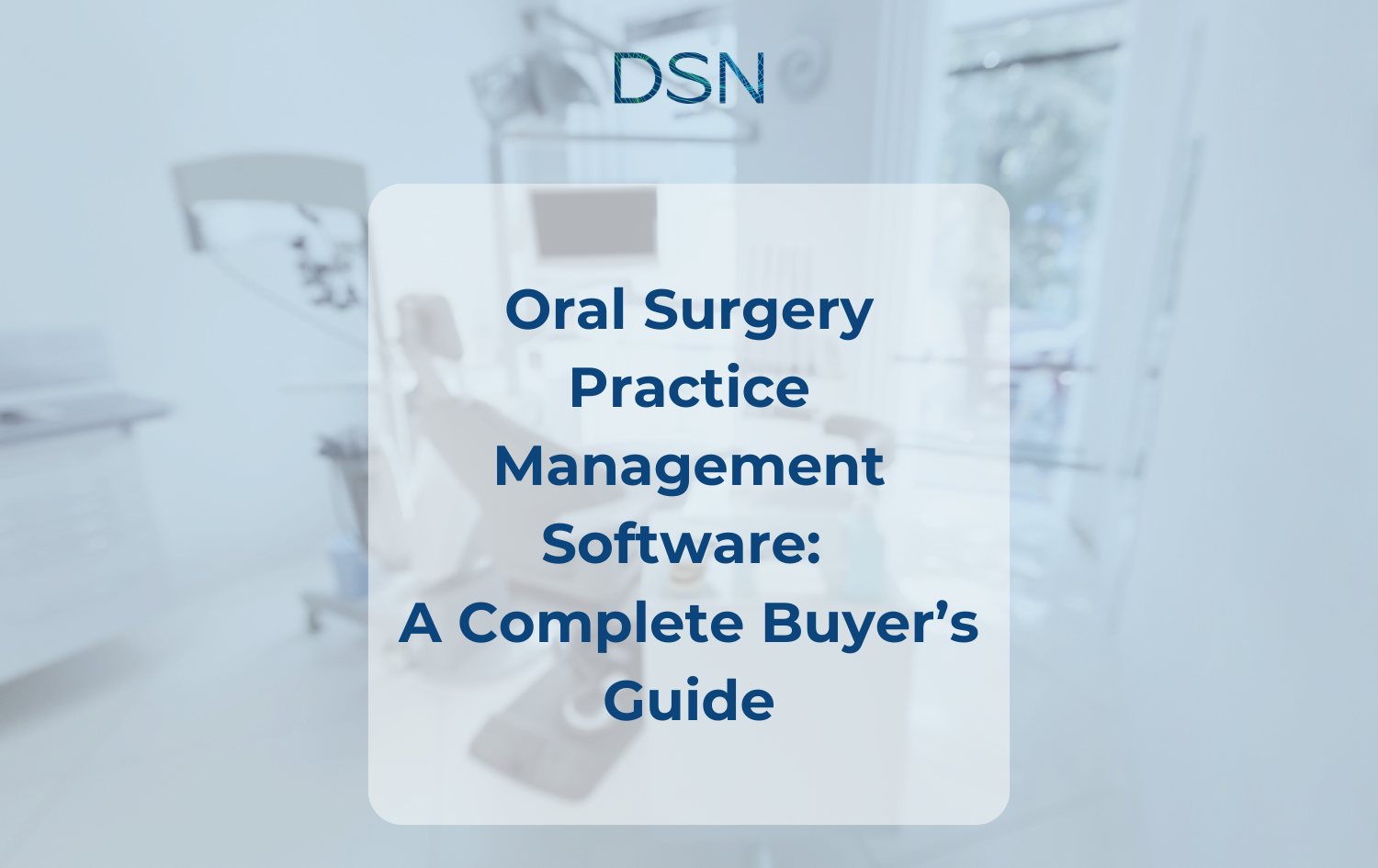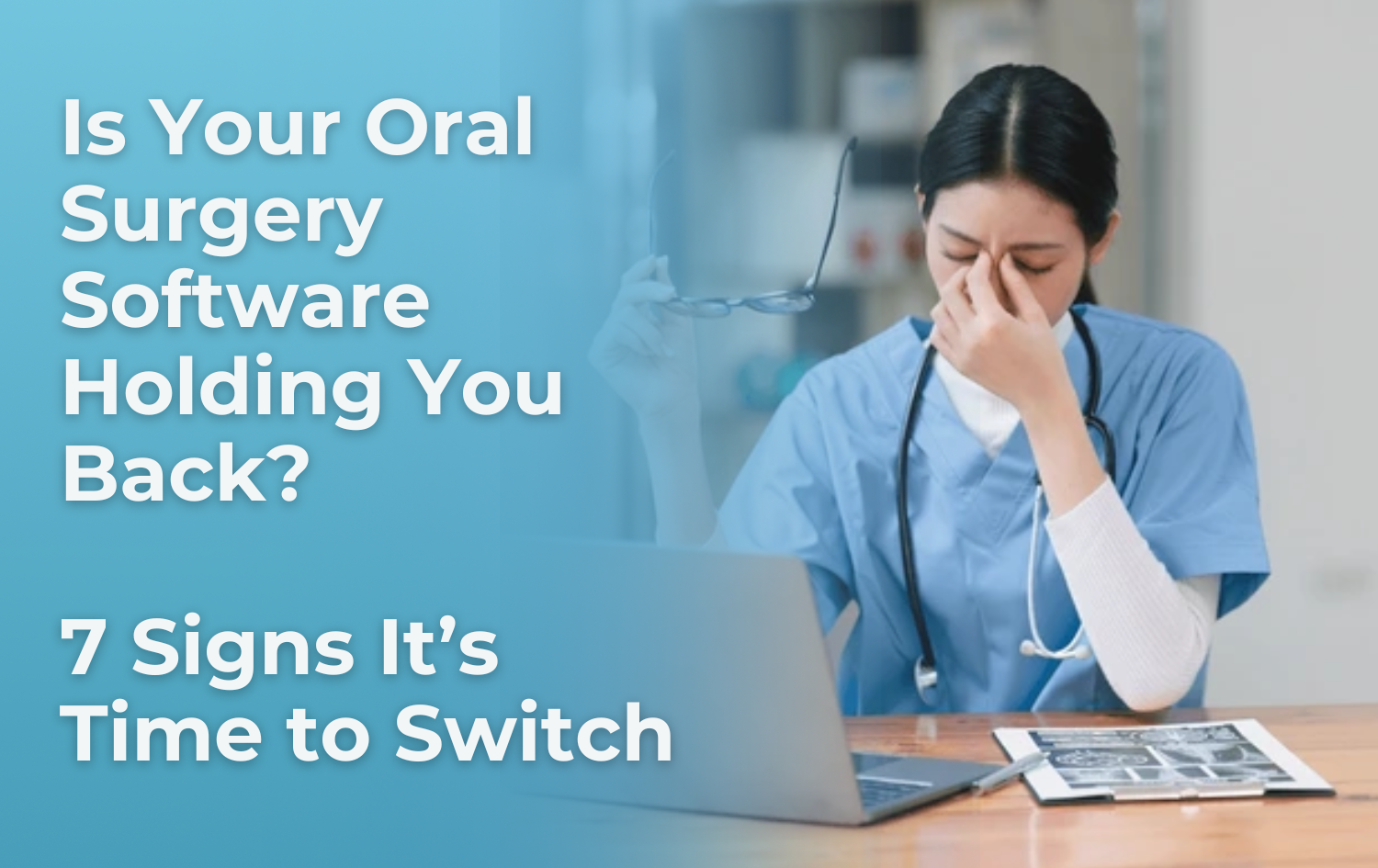Blog Overview
Is Your Oral Surgery Software Holding You Back? 7 Signs It’s Time to Switch
Written by: Isaac Shapot, Marketing Director, DSNLet’s be honest—switching oral surgery software is about as appealing as performing your own root canal. You don’t want to do it, you’ll procrastinate doing it, and by the time you finally do it, you’re wondering why you didn’t get it over with sooner.
But here’s the truth: the longer you stick with outdated, clunky, or just plain frustrating oral surgery software, the more it chips away at your efficiency, your growth potential, and—maybe most importantly—your peace of mind.
Now, if you’re reading this and thinking, Well, my system gets the job done, take a second and ask yourself: at what cost? Because “gets the job done” usually translates to “barely functional but too annoying to fix.”
Here are seven signs your oral surgery software might actually be holding you back—and how to know when it’s time to pull the plug and move on.
1. You’re Still Toggling Between Systems All Day
Let’s start with the obvious pain point: the tab shuffle. Your front desk team has one monitor, five programs, and a post-it note maze of passwords just to check in a single patient. It’s like modern-day multitasking meets digital chaos.
Maybe your imaging software lives in one system. Your schedule’s buried in another. Billing? Oh, that’s over in the legacy interface no one really knows how to use anymore. And then there’s e-prescribing, notes, referral letters, and on and on.
It’s not just inefficient—it’s exhausting. And that kind of disjointed workflow leads to mistakes. When you’re copying and pasting between platforms, things get missed. Claims go out with wrong info. Notes get lost. Imaging doesn’t sync. And guess who deals with the fallout?
Integrated oral surgery software should pull everything under one roof. Imaging, scheduling, billing, referrals, prescriptions—connected. So your team can actually focus on care, not clicking.
2. Your Team Is Drowning in Manual Work
You didn’t go to dental school to become a data entry clerk. And neither did your staff. But somehow, every day feels like a never-ending scroll of tasks that your software should be automating—but isn’t.
If your team is hand-typing every claim, manually tracking implant inventory, writing sticky notes to follow up on referrals, and still faxing documents in 2025… that’s a big, blinking red flag.
The best oral surgery software doesn’t just store data—it helps you act on it. It should autofill known info, queue up recurring tasks, track incomplete items, and follow logic that matches your day-to-day reality. Otherwise, your team is stuck doing the digital equivalent of pushing paper uphill.
And let’s not forget the human cost here. Manual work is draining. It increases burnout, reduces focus, and eventually chips away at morale. Happy teams aren’t just about free snacks and Friday lunches—they’re about having tools that actually help them do their job.
3. You Can’t Access What You Need—When You Need It
You’re out of the office but get a text from your on-call surgeon. A patient’s post-op scan has a potential issue and you need to take a look. Easy, right?
Not if your software is trapped on a server behind a firewall in your practice and you didn’t bring the right laptop. Not if your VPN expired. Not if the system only runs on Windows and you’re holding a MacBook.
Cloud-based oral surgery software exists to eliminate that kind of friction. You should be able to securely log in from a tablet, phone, or desktop and get exactly what you need—without digging through third-party software or waiting until Monday morning.
Access isn’t just about convenience. It’s about responsiveness, accountability, and flexibility. It lets you answer questions, adjust plans, and collaborate with referring doctors in real time.
And let’s be real: patients expect this now. If Amazon can track a $12 package in real time, they don’t want to hear “we’ll call you back once we check the chart tomorrow.”
4. Reporting Feels Like a Math Exam
Let’s talk numbers—production, collections, case acceptance, referral trends. These are the metrics that tell you how healthy your practice actually is.
But if pulling those numbers feels like deciphering an IRS form, your software is probably part of the problem.
Basic things—like knowing which payers are holding up your AR or which referring doctors haven’t sent a case in six months—shouldn’t require ten clicks and a CSV export. If your software’s reporting is limited to canned dashboards with little customization, you’re operating with blind spots.
Strong reporting is the backbone of smart decisions. Whether you’re opening a second location, hiring a new associate, or just trying to hit monthly goals, you need clean, actionable data. Not static charts from 2014.
The best oral surgery software doesn’t make you find insights—it puts them in front of you.
5. Training New Staff on Your Oral Surgery Software Feels Like Bootcamp
You’ve hired someone great. They’re smart, personable, ready to learn. But your software? It feels like learning Morse code underwater.
Every platform has a learning curve. But if onboarding a new employee takes weeks—or if even your seasoned team is still unsure where key features live—it’s not a training problem. It’s a design problem.
Software shouldn’t feel like a puzzle. Especially not in a surgical setting where the margin for error is razor thin. Navigation should feel intuitive. Tasks should follow a logical flow. And common actions (like submitting a claim or attaching an image) should be dead simple.
If you’re constantly answering the same five questions about your system, maybe the system isn’t pulling its weight.
6. You’re Always Waiting on Support (or You’ve Stopped Calling)
There’s a special kind of dread that comes with calling your software vendor’s support line. You brace yourself. You get the hold music. You pray the rep actually understands oral surgery.
And sometimes—let’s admit it—you don’t even call. You just… work around the issue. You patch things up with a workaround. You hope no one notices. That’s when support has stopped being a resource and started being a liability.
Support isn’t just about fixing problems. It’s about trust. It’s knowing that when your system goes down the morning of four big surgeries, there’s someone on the line who gets how urgent that is. Not someone reading from a script.
If your current vendor treats you like a ticket number instead of a partner, it might be time to reconsider what you’re paying for.
7. You’re Stuck in 2011 (And So Is Your Software)
Let’s paint the picture. Grey windows. Tiny buttons. A weird file structure that only one person on staff understands. And an icon on the desktop that hasn’t changed since Bush was in office.
If your oral surgery software looks and feels outdated, it probably is. And the consequences go beyond aesthetics.
Older systems are harder to update. They’re often incompatible with new devices. They rely on aging servers, manual backups, and IT patches that get more fragile with time. And don’t even get started on security—some of these platforms were never built to handle modern threats like ransomware or phishing attacks.
Modern software should be updated regularly—ideally monthly—to keep up with everything from e-prescribing rules to security requirements to UI improvements. If your system hasn’t had a major update in years? That’s not reliability. That’s stagnation.
And trust us—your patients notice when your technology feels behind. It reflects on your whole brand.
So… What’s Actually Stopping You?
We hear it all the time. “I know we should probably switch… but we’re just too busy right now.” And sure, that’s fair. The idea of migrating data, retraining staff, and potentially disrupting your flow? It’s enough to make anyone hesitate.
But here’s the truth most surgeons tell us after they switch: the transition was easier than expected. And more importantly, it was worth it.
Because once you’re in a system that works for you—not against you—everything else starts to fall into place. You collect faster. Your staff breathes easier. Referrals get processed faster. And those end-of-month reports you dreaded? They practically build themselves.
Here’s the bottom line: You don’t have to settle. Not for slow support, not for clunky workflows, and definitely not for oral surgery software that feels like it belongs in a museum.
DSN Cloud was built specifically for surgical specialists—oral surgeons, periodontists, and endodontists who need power, speed, and reliability. It’s not a dental platform trying to be something it’s not. It’s a purpose-built tool for practices like yours. With U.S.-based support, seamless cloud access, integrated imaging, and real-time updates that actually improve your day-to-day.
If your current system feels like a burden, maybe it’s time to let go of “just good enough.”
Because the longer you wait, the further ahead your competitors get—and the more you’re working around a system that should be working for you.
Want a cleaner, calmer, more capable platform?
Let’s talk. No pressure. Just possibilities.
Our Recent Blog Posts

Oral Surgery Practice Management Software: A Complete Buyer’s Guide
Let’s be honest—switching oral surgery software is about as appealing as performing your own root canal. You don’t want to...
Read More
Is Your Oral Surgery Software Holding You Back? 7 Signs It’s Time to Switch
Let’s be honest—switching oral surgery software is about as appealing as performing your own root canal. You don’t want to...
Read More